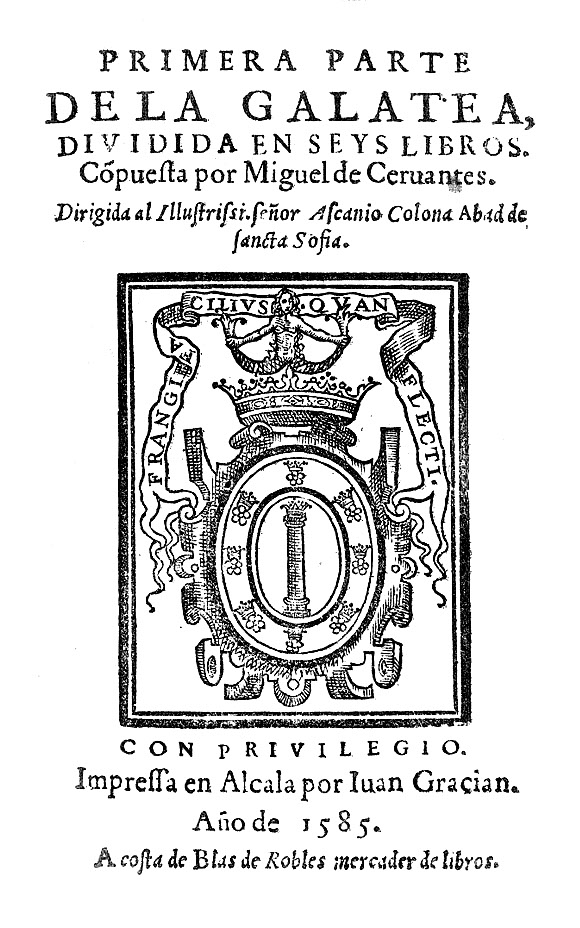 La Galatea was Miguel de Cervantes’ first book, published in 1585. Under the guise of pastoral characters, it is an examination of love and contains many allusions to contemporary literary figures. It enjoyed a modest success, but was not soon reprinted; its promised sequel was never published, and presumably never written.
La Galatea was Miguel de Cervantes’ first book, published in 1585. Under the guise of pastoral characters, it is an examination of love and contains many allusions to contemporary literary figures. It enjoyed a modest success, but was not soon reprinted; its promised sequel was never published, and presumably never written.
Plot
The main characters of the Galatea are Elicio and Erastro, best friends and enamoured with Galatea. The novel opens with her and her best friend, Florisa, bathing, talking of love. Erastro and Elicio reveal to each other their desire for Galatea, but agree not to let it come between their friendship. Eventually, all four of them begin their journey to the wedding of Daranio and Silveria, along which, in the pastoral tradition, they encounter other characters who tell their own stories and often join the traveling group.
The vast majority of the characters in the book are involved primarily in minor story lines. Lisandro loses his love, Leonida, when Crisalvo mistakenly kills her instead of his former love Silvia. Lisandro avenges Leonida's death in the presence of the main party. Astor, under the pseudonym Silerio, feigns attraction for Nísida’s sister Blanca in order to avoid the scorn of Nísida’s lover Timbrio, who dies following the confusion present after a successful duel against his rival Pransiles. Astor’s grief thrusts him into hermitage, waiting to hear from Nísida. Arsindo holds a poetry competition betwixt Francenio and Lauso, which is judged by Tirsi and Damón, lauded by many within the novel as some of the most famous poets of Spain. The competition is determined to have no single winner. The wedding has controversy as Mireno is deeply in love with Silveria, yet Daranio’s wealth guaranteed him the hand of Silveria.
These stories sometimes have characters that cross over, resulting in the sub-plots being intertwined at times. For example, Teolinda, whose sister Leonida played in an integral role in separating Teolinda from her lover Artidoro, finds Leonida much later with a group of soldiers. The fame of Tirsi and Damón instantly connects them with the hired wedding bards, Orompo, Crisio, Marsilio, and Orfenio, as well as the teacher Arsindo.
Review
La Galatea is an imitation of the Diana of Jorge de Montemayor, and shows an even greater resemblance to Gil Polo's continuation of the Diana. Next to Don Quixote and the Novelas exemplares, his pastoral romance is considered particularly notable because it predicts the poetic direction in which Cervantes would go for the rest of his career. It possesses little originality, but is highly reminiscent of its models, and particularly of the Diana of Gil Polo.
In composing this pastoral romance, Cervantes seems to have intended to use the tale merely as an excuse for a rich collection of poems in the old Spanish and Italian styles. The story is merely the thread, which holds the beautiful garland together; the poems are the portion most deserving of attention. They are many and various, and uphold Cervantes' claim to rank among the most eminent poets, whether in reference to verse or to prose. Should his originality in versified composition be called in question, a close study of Galatea must banish all doubt.
Contemporaries of Cervantes claimed that he was incapable of writing poetry, and that he could compose only beautiful prose; but that observation referred solely to his dramatic works. Every critic sufficiently acquainted with his lyrical compositions has rendered justice to their merit. From the romance of Galatea, it is obvious that Cervantes composed in all the various kinds of syllabic measure used in his time. He even occasionally adopted the old dactylic stanza. He appears to have experienced some difficulty in the metrical form of the sonnet, but his poems in Italian octaves display great facility. Among these, the song of Caliope, in the last book of the Galatea, stands out.
In the same manner as Gil Polo in his Diana, he makes the river Turia pronounce the praises of the celebrated Valencians. The poetic fancy of Cervantes summons the muse Calliope before the shepherds and shepherdesses, to render solemn homage to those contemporaries whom he esteems worthy of distinction as poets. The most beautiful poems in the Galatea are a few in the cancion style, some of which are iambics, and some in trochaic or Old Spanish verse. Cervantes has here and there indulged in those antiquated and fantastic plays of wit, which at a subsequent period he himself ridiculed.

